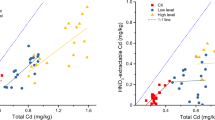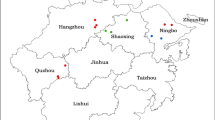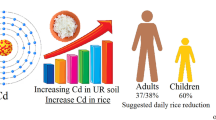Abstract
Purpose
Soil management strategies for agricultural lands contaminated with potentially toxic trace elements, especially cadmium (Cd), are still inadequate and require a precise identification of soils that are not s afe for growing crops. Key soil variables need to be identified to connect soil safety with food safety by reliable models.
Materials and methods
Soil variables that affect concentrations of metals in different portions of radish, Raphanus sativus L., were examined as part of a greenhouse experiment. 0.01 M di-sodium-di-hydroxy-ethylenediamine-tretra-acetic acid (Na2H2EDTA) solution was used in a strong rinsing experiment. Cd soil-radish relationships were derived by different modeling approaches and were used to develop local risk screening values for Cd in soil.
Results and discussion
The current lab washing procedures readily remove surface Cd adherence but are not adequate to remove surface-deposited lead (Pb), thus overestimating bioaccumulation in plants by mean 111%. Shoot and root tissue Cd concentration in fresh weight basis do not present a significant difference and can be precisely predicted by regression models using different Cd pools and soil pH. Preferably a polynomial surface model can be used in developing local rick screening values that yield concentrations of Cd in radish at or below the Chinese food quality standard of 0.1 mg kg−1 (fresh weight).
Conclusions
The bioaccumulation of Cd in radish depends on the Cd bioavailability in soil. But for Pb, surficial particle contamination masks the realistic bioaccumulation. We also demonstrated the usefulness of the polynomial surface model to develop local soil protection guidelines that are helpful to local farmers for proper soil management and avoidance of Cd exceedance in food.





Similar content being viewed by others
References
Adams ML, Zhao FJ, McGrath SP, Nicholson FA, Chambers BJ (2004) Predicting cadmium concentrations in wheat and barley grain using soil properties. J Environ Qual 33(2):532–541
Bi X, Feng X, Yang Y, Li X, Shin GP, Li F, Qiu G, Li G, Liu T, Fu Z (2009) Allocation and source attribution of lead and cadmium in maize (Zea mays L.) impacted by smelting emissions. Environ Pollut 157(3):834–839
Boshoff M, De Jonge M, Scheifler R, Bervoets L (2014) Predicting As, Cd, Cu, Pb and Zn levels in grasses (Agrostis sp and Poa sp.) and stinging nettle (Urtica dioica) applying soil-plant transfer models. Sci Total Environ 493:862–871
Brus DJ, Jansen MJW (2004) Uncertainty and sensitivity analysis of spatial predictions of heavy metals in wheat. J Environ Qual 33(3):882–890
Brus DJ, de Gruijter JJ, Walvoort DJJ, de Vries F, Bronswijk JJB, Romkens P, de Vries W (2002) Mapping the probability of exceeding critical thresholds for cadmium concentrations in soils in the Netherlands. J Environ Qual 31(6):1875–1884
Chamberlain A (1983) Fallout of lead and uptake by crops. Atmos Environ (1967) 17(4):693–706
Chen H, Teng Y, Lu S, Wang Y, Wang J (2015) Contamination features and health risk of soil heavy metals in China. Sci Total Environ 512:143–153
dos Santos-Araujo SN, Swartjes FA, Versluijs KW, Moreno FN, Alleoni LRF (2017) Soil-plant transfer models for metals to improve soil screening value guidelines valid for Sao Paulo, Brazil. Environ Monit Assess 189(12):615
Duffner A, Hoffland E, Weng LP, Sjoerd EATM (2013) Predicting zinc bioavailability to wheat improves by integrating pH dependent nonlinear root surface adsorption. Plant Soil 373(1–2):919–930
Gong ZT, Lei WJ, Cao SG (1994) Systematic classification of arid soils in China. Progress Soil Sci 22(02):45–47
Haghiri F (1973) Cadmium uptake by plants. J Environ Qual 2(1):93–95
Houba VJG, Novozamsky I, Lee JJ (1992) Soil testing and plant analysis in western Europe. Commun Soil Sci Plant Anal 23(17–20):2029–2051
Houba VJG, Temminghoff EJM, Gaikhorst GA (2000) Soil analysis procedures using 0.01 M calcium chloride as extraction reagent. Commun Soil Sci Plant Anal 31(9–10):1299–1396
Hough RL, Young SD, Crout NMJ (2003) Modelling of Cd, Cu, Ni, Pb and Zn uptake, by winter wheat and forage maize, from a sewage disposal farm. Soil Use Manag 19(1):19–27
John MK (1972) Uptake of soil-applied cadmium and its distribution in radishes. Can J Plant Sci 52(5):715–719
Kalis EJJ, Temminghoff EJM, Visser A, Van Riemsdijk WH (2007) Metal uptake by Lolium perenne in contaminated soils using a four-step approach. Environ Toxicol Chem 26:335–345
Kalis EJ, Temminghoff EJ, Town RM, Unsworth ER, Van Riemsdijk WH (2008) Relationship between metal speciation in soil solution and metal adsorption at the root surface of ryegrass. J Environ Qual 37:2221–2231
Legind CN, Trapp S (2010) Comparison of prediction methods for the uptake of As, Cd and Pb in carrot and lettuce. SAR QSAR Environ Res 21(5–6):513–525
Lu RK (2000) Analytical methods of soil and agricultural chemistry. China Agricultural Science and Technology Press, Beijing, pp 107–240
Luo YM (2018) Regional difference in soil pollution and strategy of soil zonal governace and remediation in China. Chin Sci Bull 2:145–152
Marchiol L, Assolari S, Sacco P, Zerbi G (2004) Phytoextraction of heavy metals by canola (Brassica napus) and radish (Raphanus sativus) grown on multicontaminated soil. Environ Pollut 132(1):21–27
McBride MB (2002) Cadmium uptake by crops estimated from soil total Cd and pH. Soil Sci 167(1):62–67
McBride MB, Sauve S, Hendershot W (1997) Solubility control of Cu, Zn, Cd and Pb in contaminated soils. Eur J Soil Sci 48(2):337–346
McBride MB, Simon T, Tam G, Wharton S (2013) Lead and arsenic uptake by leafy vegetables grown on contaminated soils: effects of mineral and organic amendments. Water Air Soil Pollut 224(1):1378
McBride MB, Shayler HA, Spliethoff HM, Mitchell RG, Marquez-Bravo LG, Ferenz GS, Russell-Anelli JM, Casey L, Bachman S (2014) Concentrations of lead, cadmium and barium in urban garden-grown vegetables: the impact of soil variables. Environ Pollut 194:254–261
McGrath SP, Zhao FJ (2015) Concentrations of metals and metalloids in soils that have the potential to lead to exceedance of maximum limit concentrations of contaminants in food and feed. Soil Use Manag 31:34–45
Ministry of Ecology and Environment (1997). Soil quality—determination of Lead, cadmium—graphite furnace atomic adsorption spectrophotometry (GB/T 17141). T. a. S. (Ed) Department of Science, China
Naghipour D, Chenari MA, Taheri N, Naghipour F, Mehrabian F, Attarchi MS, Jaafari J, Roubakhsh E (2018) The concentration data of heavy metals in vegetables of Guilan province, Iran. Data Brief 21:1704–1708
Nicholson FA, Jones KC, Johnston AE (1995) The significance of the retention of atmospherically deposited cadmium on plant surfaces to the cadmium content of herbage. Chemosphere 31(4):3043–3049
Römkens PF, Guo HY, Chu CL, Liu TS, Chiang CF, Koopmans GF (2009) Prediction of cadmium uptake by brown rice and derivation of soil-plant transfer models to improve soil protection guidelines. Environ Pollut 157(8–9):2435–2444
Römkens P, Brus DJ, Guo HY, Chu CL, Chiang CM, Koopmans GF (2011) Impact of model uncertainty on soil quality standards for cadmium in rice paddy fields. Sci Total Environ 409(17):3098–3105
Roy M, McDonald LM (2015) Metal uptake in plants and health risk assessments in metal-contaminated smelter soils. Land Degrad Dev 26(8):785–792
Singh S, Zacharias M, Kalpana S, Mishra S (2012) Heavy metals accumulation and distribution pattern in different vegetable crops. J Environ Chem Ecotoxicol 4(4):75–81
Tchounwou PB, Yedjou CG, Patlolla AK, Sutton DJ (2012) Heavy metal toxicity and the environment. In: Molecular, Clinical and Environmental Toxicology Springer, pp 133–164
Yeomans JC, Bremner JM (1988) A rapid and precise method for routine determination of organic carbon in soil. Commun Soil Sci Plant Anal 19:1467–1476
Zhang S, Song J, Gao H, Zhang Q, Lv MC, Wang S, Liu G, Pan YY, Christie P, Sun WJ (2016) Improving prediction of metal uptake by Chinese cabbage (Brassica pekinensis L.) based on a soil-plant stepwise analysis. Sci Total Environ 569:1595–1605
Zhang S, Song J, Cheng Y, McBride MB (2018a) Derivation of regional risk screening values and intervention values for cadmium-contaminated agricultural land in the Guizhou plateau. Land Degrad Dev 29(8):2366–2377
Zhang S, Song J, Cheng YW, Christie P, Long J, Liu LF (2018b) Derivation of reliable empirical models describing lead transfer from metal-polluted soils to radish (Raphanus sativa L.): determining factors and soil criteria. Sci Total Environ 613-614:72–80
Zhao FJ, Adams ML, Dumont C, McGrath SP, Chaudri AM, Nicholson FA, Chambers BJ, Sinclair AH (2004a) Factors affecting the concentrations of lead in British wheat and barley grain. Environ Pollut 131(2):461–468
Zhao FJ, Adams ML, Dumont C, McGrath SP, Chaudri AM, Nicholson FA, Chambers BJ, Sinclair AH (2004b) Factors affecting the concentrations of lead in British wheat and barley grain. Environ Pollut 131(3):461–468
Funding
This work was funded by the STS Program of the Chinese Academy of Sciences (no. KFJ-STS-ZDTP-005) and the National Environmental Protection Public Welfare Industry Targeted Research Fund (201409042).
Author information
Authors and Affiliations
Corresponding author
Ethics declarations
Conflict of interest
The authors declare that they have no competing interests.
Additional information
Responsible editor: Claudio Bini
Publisher’s note
Springer Nature remains neutral with regard to jurisdictional claims in published maps and institutional affiliations.
Electronic supplementary material
ESM 1
(DOCX 296 kb)
Rights and permissions
About this article
Cite this article
Xu, G., Zhang, S., Song, J. et al. Cadmium uptake in radish (Raphanus sativus L.) and surficial contamination: implications for food safety and local soil management. J Soils Sediments 19, 3585–3596 (2019). https://doi.org/10.1007/s11368-019-02290-x
Received:
Accepted:
Published:
Issue Date:
DOI: https://doi.org/10.1007/s11368-019-02290-x




